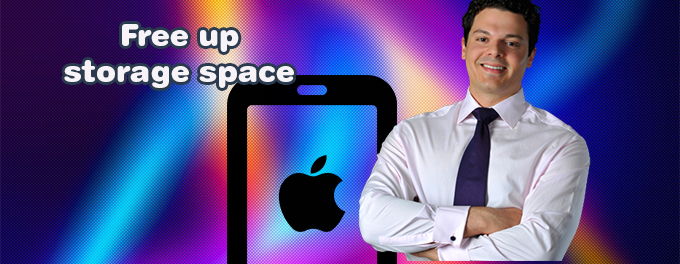Free up storage space on iPhone [2025] 💥

iPhones today have huge storage, and even more storage if you don't mind paying extra. It's easy to fill that space with photos, videos and music though. Apple knows this and has built-in tools that will help you manage your phone's storage. We'll show you six ways to free up space on your iPhone. All of them are very easy.
Advertisement
1. Offload and delete seldomly used apps
Your iPhone may be running out of storage because you use iOS apps, especially if your iPhone is used for gaming. Our first suggestion for how to free up space on your iPhone is to delete and "offload" apps. Follow these steps:
- Open the Settings app. Scroll down and choose "General" >> "iPhone Storage". Wait a while until your phone calculates how many free spaces you have.
- This option gives iOS control. Select "Offload Unused Applications" to allow your iPhone to decide which apps should be deleted. This will preserve all your personal data, documents, media and media. It will not delete apps you rarely use and only when storage is low.
- You have complete control over the second option. You can select each app (already sorted according to size) and then tap on the app you don't want. This will display additional information. Here you will find the "Delete App", which deletes all its data from your iPhone.
2. Reduce photo file size
The iPhone's camera has grown in size over the past few years. But, these additional megapixels can now lead to huge file sizes. Optimizing your photos can help you free up space on your iPhone.
- Start the Settings app. Scroll down a lot and tap on "Camera".
- You'll be presented with a few options when you click on "Formats". We recommend choosing "High Efficiency", which will tell the Camera app to use HEIF/HEVC formats. You will get photos that look exactly the same as before but with a smaller file size.
- You'll also see the option to shoot in ProRAW if you have an iPhone. Be aware that ProRAW images can be very large in size. This feature is not necessary unless you are a professional photographer and edit images.
- Navigate to Settings and click on "General" >> "iPhone Storage".
- To manage offline data, choose the app that you prefer. If you have a lot of music stored locally, then open the "Music app." You might also have many podcasts stored in the "Podcasts” app. You can store offline files in media streaming apps like Netflix, Disney Plus, Hulu, and Hulu.
- After you select each app, you will see its complete overview. This is also where you will see any data that has been saved for offline use. It's conveniently located at the bottom of your screen. You can delete that data by clicking on each file at the right edge.
- Scroll down in the Settings app and select "Safari".
- Choose "Clear History" >> "Website Data". That's all!
You should also delete duplicate burst images from your iPhone. These photos can take up a lot of storage, especially if the Camera app isn't optimized as described above.
3. Delete local media
You can easily eat up your storage if you download music or podcasts to listen offline, or use media streaming services to download TV shows and movies. This article will show you how to delete those files and recover some storage.
4. Clear Safari
You probably have several cookies and other files on your iPhone if you use Safari every day. Although they aren't large, you can remove them to free up space on your iPhone. Follow these steps:
5. Store video and photo on iCloud
You can also save photos and other files to the cloud to free up space on your iPhone. iCloud is the best cloud service for iPhone users. Your photos and videos will be the first things you want to transfer into iCloud. These items can take up lots of space.
iCloud Drive, an iOS default app that stores your files, is available. Your files will be stored there once you have started using iCloud. This can be changed in the iCloud settings, as described below.
6. Create local backup and restore your iPhone
Sometimes, your iPhone might not give you an accurate report about how much space you have. You can fix this by backing up your iPhone and then restoring it locally.
Advertisement
